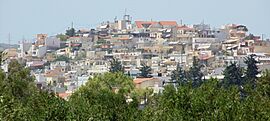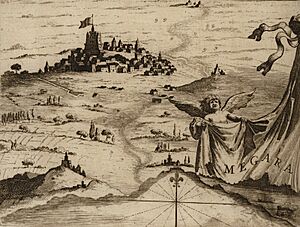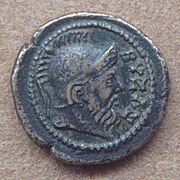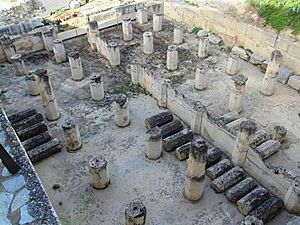Megara facts for kids
Quick facts for kids
Megara
Μέγαρα
|
|
|---|---|
 |
|
| Country | Greece |
| Administrative region | Attica |
| Regional unit | West Attica |
| Area | |
| • Municipality | 330.1 km2 (127.5 sq mi) |
| • Municipal unit | 322.2 km2 (124.4 sq mi) |
| Elevation | 4 m (13 ft) |
| Population
(2021)
|
|
| • Municipality | 38,033 |
| • Municipality density | 115.217/km2 (298.41/sq mi) |
| • Municipal unit | 30,773 |
| • Municipal unit density | 95.509/km2 (247.37/sq mi) |
| Community | |
| • Population | 29,122 (2021) |
| Time zone | UTC+2 (EET) |
| • Summer (DST) | UTC+3 (EEST) |
| Postal code |
191 00
|
| Area code(s) | 22960 |
| Website | www.megara.gr |
Megara (pronounced "MEG-uh-ruh") is an ancient and important town in West Attica, Greece. It's located on a narrow strip of land called the Isthmus of Corinth. This land connects mainland Greece to the Peloponnese peninsula.
Megara is right across from the island of Salamis. Long ago, Salamis belonged to Megara. Later, the powerful city of Athens took control of it. Megara was once one of the four main areas of Attica. It was said to be ruled by King Nisos, one of the mythical sons of King Pandion II.
Megara was also a busy trading port. Its people used their ships and wealth to gain power. They traded wool and other animal products, like horses. The city had two important harbors. Pagae was to the west on the Corinthian Gulf. Nisaea was to the east on the Saronic Gulf of the Aegean Sea.
Contents
A Look Back: Megara's Early Days
The people of Megara believed their town was founded by a person named Car. He was the son of Phoroneus. Car built a fortress called 'Caria' and temples to the goddess Demeter. These temples were called Megara, which is how the town got its name.
How Megara Grew and Fought
In ancient times, Megara was connected to Corinth. People from Megara even started a small city, or polis, called Megara Hyblaea in Sicily. Later, Megara fought a war to become independent from Corinth. After winning, Megara founded other important cities. These included Chalcedon in 685 BC and Byzantium around 667 BC.
Megara also had strong connections with Miletos, a city in Asia Minor. Some historians believe they had a "colonization alliance." This meant they worked together to set up new settlements. Both cities followed advice from Apollo's oracles. Megara consulted the oracle at Delphi, while Miletos had its own oracle at Didyma.
Around the late 600s BC, a man named Theagenes became the ruler, or "tyrant," of Megara. He gained power by helping the poor. He did this by taking cattle from the rich.
Megara in Famous Wars
During the second Persian invasion of Greece (480–479 BC), Megara joined forces with Sparta and Athens. Megarian soldiers fought bravely in key battles. These included the famous Battle of Salamis and the Battle of Plataea.
Later, around 460 BC, Megara left the Spartan-led Peloponnesian League. This was because of arguments over land with its neighbor, Corinth. This decision helped start the First Peloponnesian War (460–445 BC). But by 446 BC, Megara was forced to rejoin the Peloponnesian League.
In the second Peloponnesian War (431–404 BC), Megara was an ally of Sparta. A rule called the Megarian decree was a major cause of this war. Athens issued this decree, which stopped Megarian merchants from trading in areas controlled by Athens. This was meant to hurt Megara's economy. Athens claimed Megara had disrespected a sacred area near their border.
Famous People from Megara
Megara was home to several important figures in ancient times.
- Byzas was a legendary founder of Byzantium in the 600s BC.
- The poet Theognis lived in Megara in the 500s BC.
- In the early 300s BC, Euclid of Megara started the Megarian school of philosophy. This school was famous for using logic and dialectic (a way of discussing ideas).
Megara's Later Challenges
In 279 BC, during a Celtic invasion, Megara sent 400 peltasts (light infantry soldiers) to Thermopylae. Later, in 266 BC, the Macedonian king Antigonus Gonatas attacked Megara. The Megarians bravely fought off his war elephants using a clever trick: they used burning pigs! Even with this success, Megara eventually had to submit to the Macedonians.
In 243 BC, Megara joined the Achaean League. This was a group of Greek city-states. But when the Achaeans lost control of the Isthmus in 223 BC, Megara left them. They then joined the Boeotian League. However, Megara soon grew tired of the Boeotians and rejoined the Achaean League around 203 or 193 BC.
According to the ancient writer Plutarch, around 48 BC, Megarians tried to use lions against Roman soldiers. But the lions attacked their own unarmed citizens instead.

The people of Megara were known for being very generous in building temples. There was a saying about them: "They build as if they are to live forever; they live as if they are to die tomorrow." This meant they planned for the future but lived for today.
How Megara Practiced Democracy
Megara had periods where it was a democracy, meaning its citizens had a say in how it was run.
When Democracy Flourished
The first time Megara was a democracy was between 427 BC and 424 BC. During this time, there was an uprising by the people. Later, a small group of wealthy families took control.
Megara became a democracy again in the 370s BC. The people of Megara even kicked out some groups who were trying to stop democracy. By the 350s BC, however, it seems Megara was back to being ruled by a small group.
When the small group took over in 424 BC, one of their first actions was to make people vote openly. This suggests that the democracy before them used a secret ballot. Megarian democracy also used ostracism. This was a way to temporarily banish someone from the city if they were seen as a threat. The democracy also had a popular Assembly and Council, and a group of five or six generals.
Some historians believe Megara was also a democracy in the 500s BC. During this time, the government made it illegal to charge interest on loans. They even made lenders return interest they had already collected.
Megara's Location and Surroundings
Megara is in the western part of Attica. It is close to the Megara Gulf, which is a part of the Saronic Gulf. The flat coastal area around Megara is called Megaris. This was also the name of the ancient city-state centered on Megara.
Megara is located:
- 8 km west of Nea Peramos
- 18 km west of Elefsina
- 19 km east of Agioi Theodoroi
- 34 km west of Athens
- 37 km east of Corinth
Getting Around Megara
Roads
The Motorway 8 connects Megara to the cities of Athens and Corinth.
Trains
The Megara railway station has Proastiakos suburban trains. These trains go to Athens and Kiato.
Air Travel
There is a small military airfield south of the town. Its code is LGMG.
Megara as a Municipality
The modern municipality of Megara was created in 2011. It combined two older municipalities: Megara and Nea Peramos. In 2017, Kineta became its own separate community within the Megara area.
The total area of the municipality is about 330.11 square kilometers. The main municipal unit of Megara covers about 322.21 square kilometers.
Areas and Neighborhoods
- Agia Triada
- Aigeirouses
- Kineta
- Koumintri
- Lakka Kalogirou
- Moni Agiou Ierotheou
- Moni Agiou Ioannou Prodromou
- Moni Panachrantou
- Pachi
- Stikas
- Vlychada
Population Growth in Megara
| Year | Town | Municipal unit | Municipality |
|---|---|---|---|
| 1971 | 17,584 | - | - |
| 1981 | 20,814 | 21,245 | - |
| 1991 | 20,403 | 25,061 | - |
| 2001 | 23,032 | 28,195 | - |
| 2011 | 23,456 | 28,591 | 36,924 |
| 2021 | 25,467 | 30,773 | 38,033 |
Sports Teams
- Vyzas F.C. is a local football (soccer) team.
Well-Known People from Megara

- Orsippus (8th century BC), a famous runner.
- Byzas (7th century BC), the legendary founder of Byzantium.
- Theognis (6th century BC), a poet known for his elegies.
- Eupalinos (6th century BC), an engineer who built the amazing Tunnel of Eupalinos on the island of Samos.
- Theagenes (around 600 BC), a ruler of Megara.
- Euclid (around 400 BC), who started the Megarian school of philosophy.
- Stilpo (around 325 BC), a philosopher from the Megarian school.
- Teles (3rd century BC), a philosopher who followed the Cynic way of thinking.
- Giorgos Papagiannis, a professional basketball player who plays for Fenerbahçe S.K. (basketball) in Turkey.
Other Facilities
Megara has a medium-wave radio transmitter. It has a tall radio mast, 180 meters high. It broadcasts on 666 kHz and 981 kHz.
See Also
- List of ancient Greek cities
- List of settlements in Attica





